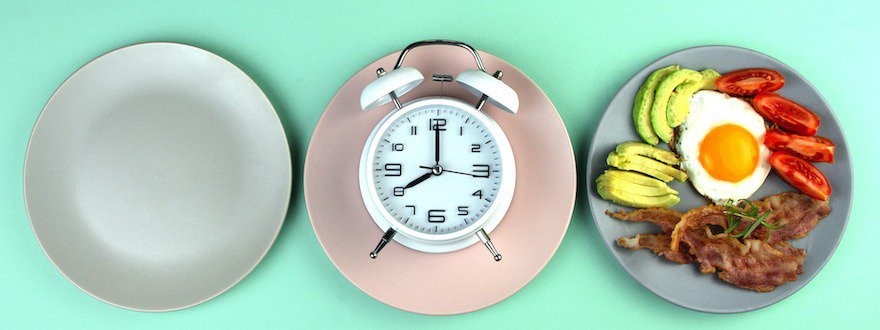What is intermittent fasting?
This practice consists of alternating periods of fasting and normal eating over a set period. It is not a complete cessation of food but rather a reduction in food intake.
This is why it is considered the easiest to implement. It is often recommended for beginners.
Each digestive rest phase should last between 12 and 16 hours. It can be done over part of the day only, for example by skipping a meal.
Fasting periods can also alternate every other day or last several consecutive days as in 5:2 intermittent fasting.
You can plan your meal program in advance.
How does it work?
16/8 Intermittent Fasting
It involves eating only part of the day or skipping a meal (breakfast, lunch, or dinner). The goal is to divide the 24-hour day into 2 time periods: 16 hours for fasting and 8 hours for eating.
You can, for example, fast after the evening meal (7 PM) until the next day’s lunch (11 AM). This way, you fast simply by sleeping.
It can also take form in a 14/10 version (14 hours for fasting and 10 hours for eating) or 12/12 (12 hours for fasting and 12 hours for eating).

5:2 Intermittent Fasting
It involves eating for 5 days a week and fasting for 2 days. On eating days, calorie intake is limited to 500 or 700 calories/day. This practice alternates complete fasting days and low intake days. It is often chosen for weight loss.
Listen | Our podcast “In Praise of Fasting” with Dr. Lionel Coudron, fasting specialist
Alternate Day Fasting
This involves stopping eating every other day of the week. It is often advised for those who fear fasting for long periods.
Unlike 5:2, there is no calorie intake limit. You can eat what you want on the eating days.
There is also a “partial” form of alternate day fasting that allows for up to 500 calories on fasting days. A good way to gradually introduce yourself to the practice.
Its Benefits
Helps with weight loss
Reducing food intake leads to a decrease in caloric intake. Undoubtedly, stopping or eating less results in weight loss.
Due to the lack of glucose, the body taps into fat to generate energy. Hence, there is a noticeable loss of abdominal fat as shown by this study.
Regenerates the liver
The liver is one of the emunctory organs that helps eliminate the body’s waste. However, it can become overloaded with toxins.
The liver takes advantage of the digestive rest to thoroughly cleanse and eliminate the toxins that clog it. This notably results in dark urine at the start of the practice.
Gradually, the liver gains in vitality and efficiency.

Reduces inflammation
Some studies have shown a reduction in pro-inflammatory cytokines, such as IL-6, levels during fasting.
This practice may be beneficial for chronic inflammatory diseases, rheumatoid arthritis, or even brain inflammation related to Alzheimer’s disease. It can also relieve inflammation during painful periods or endometriosis.
Prevents cardiovascular diseases
By reducing risk factors, it prevents the onset of cardiovascular diseases such as atherosclerosis. As shown in this study, it notably lowers blood pressure, combats oxidative stress, and improves the lipid profile (cholesterol and triglycerides).
How to practice intermittent fasting?
Preparation
A month before, it may be useful to undergo a detox cure or a revitalization cure.
The former helps start purifying the body, eliminate toxins, and cleanse the digestive system. Adopt a lighter diet based on vegetable juices, smoothies, broths, soups, and infusions.
The idea is to reduce solid foods. Avoid chocolate, coffee, and dairy products. You can continue taking dietary supplements until one day before the fast.
The revitalization cure, on the other hand, helps fill deficiencies and gain vitality. This way, your body will be less tired during the first days and you will experience fewer side effects: fatigue, dizziness, headaches…
The hypotoxic diet, which relies on a gluten-free, rapid sugar-free, lactose-free diet with gentle cooking, also helps increase the benefits of fasting.
Additionally, reduce your consumption of fatty foods and those containing refined sugar. Favor fiber-rich foods and proteins that will provide energy to your body.
Also start to eat lighter in the evening.

The meal plan
During the 8 hours of non-fasting, you should not rush to eat just any foods. The idea is not to have a “cheat meal” but to provide nutrients and energy to your body.
Favor nutritious and appetite-suppressing foods that promote satiety. We recommend the following:
- Fruits: bananas, apples, apricots, cherries…
- Vegetables: spinach, cabbage, chard…
- Sources of lean proteins: fish, chicken breast, seafood
- Sources of plant proteins: nuts, seeds, legumes…
Regarding drinks, avoid those containing sugar, artificial sweeteners, or alcohol. Opt for water or herbal teas. To prevent dehydration, drink throughout the day.
Possible activities
It is entirely possible to combine intermittent fasting and physical activity: yoga, running, weightlifting… This promotes weight loss and improves muscle development.
To avoid feeling fatigued during your sessions, protein intake should be sufficient for the chosen physical activity. Gradually, you will feel less weak and gain energy.
Finally, drink enough after exertion to prevent cramps. Ideally, do your workout at the end of the fasting period. You will be able to eat right after and replenish your energy.
Listen | Our podcast on fasting with Dr. Lionel Coudron, fasting specialist
Refeeding phase
The refeeding phase should be gradual. The longer the fast, the gentler it should be. This prevents weight gain, supports microbiome reconstruction, and continues detoxifying the body.
During the first few days, consume broths, soups, and green vegetable juices. You can then move on to salads, vegetables, fish, and chicken, but always in small quantities.
Finally, eat slowly and mindfully. The stomach needs time to assimilate the food.

Side effects and contraindications
Side effects
Side effects are especially felt during the first few days. They may include:
- headaches and dizziness
- digestive disorders
- fatigue and lack of energy
- irritability
- bad breath
- dehydration
Always practice fasting under the supervision of a doctor.
Contraindications
This practice is not recommended for the following people:
- pregnant and breastfeeding women
- people in a state of underweight
- people with eating disorders (anorexia, bulimia…)
Diabetic people and/or those on medication should consult their doctor before starting to fast.
Maximum duration
There is no real maximum duration for intermittent fasting. It can be practiced over several days, several weeks, or even several months. It depends on your body, adaptation, and goals.
In any case, you should be regularly monitored by a doctor.



